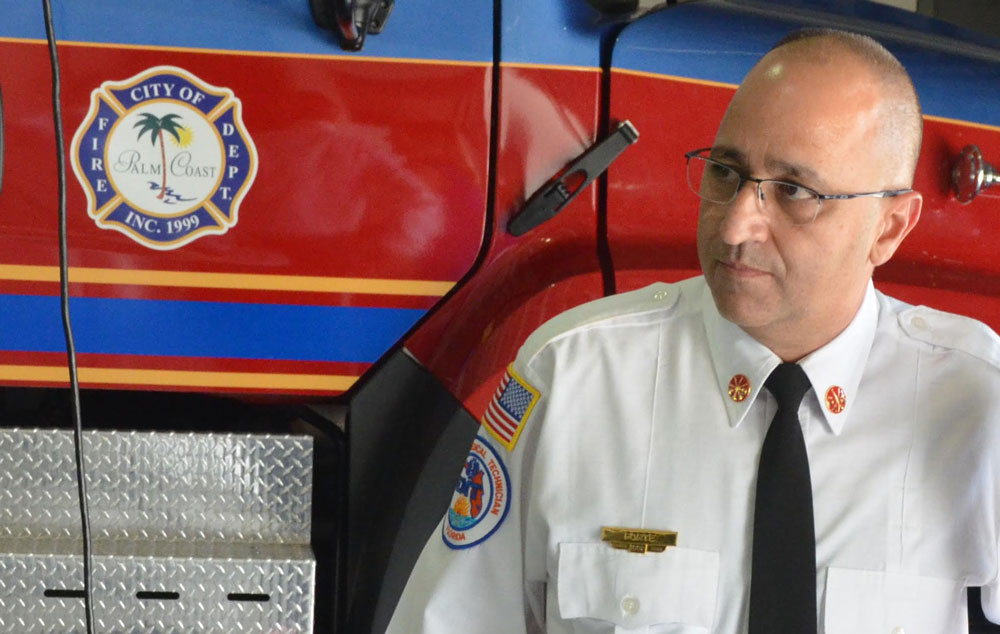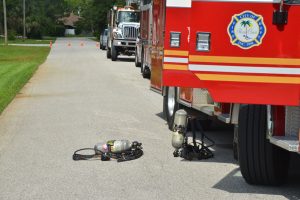
Palm Coast government is considering substantially increasing fire-impact fees to pay for three planned fire stations and their fire trucks in coming years. The fees more directly affect builders, not property owners, though the fee is generally folded into the overall cost of new properties.
The fire impact fees would rise substantially–from $223 per single family house to $367, under a current proposal before the Palm Coast City Council. A 2,000 square foot non-residential property would see the fee increase from $566 to $1,180. The proposal is based on an analysis of future demographics and, in part, on the Palm Coast Department’s 10-year plan (a plan in the works for about a year).
The 65 percent increase for residential homes and 108 percent increase for commercial space looks more staggering than it is. But in the scheme of fees, Palm Coast’s fire impact fee would remain a minuscule portion–2 percent–of the overall cost of fees, which exceed $16,000 in Palm Coast. And Palm Coast’s fire impact fees remain below the state average for comparable communities. The fire impact fee in St. Johns County, for instance, while broken down by the size of each home, is $609 for homes in the 1,800 to 2,500-square foot range, and over $1,000 for homes bigger than 3,751 square feet. In Volusia County, it’s $294.
“Our city’s growing,” Council member Eddie Branquinho said. “There are certain needs that come with it. So when you look at this impact fee, you’re talking about an increase of $143. If you divide that, anybody who buys a house, if the builder passes it on to anybody who buys a house, you’re looking at a 30-year mortgage, you’re talking about cents. So insignificant, with all due respect, because some of us, some people cannot afford that, I respect that, but you’re talking about cents a month, so I think it’s sometimes a little sacrifice we have to make in order for us to be safe.”
In addition to the new fees though, Palm Coast would raise the impact fees each year to keep up with inflation. But the fee structure should be reviewed “at least every three to five years,” Henry Thomas, vice president of Raftelis, the consultancy contracted to conduct Palm Coast’s impact fee study, advised the city council in a virtual workshop The firm has conducted other fee assessments and studies on water and sewer rates for the city. (Such studies are required by law before a government adopts new schedules.)
“That way it’s based upon recent localized data, it does reflect development trends, level of service requirements that may change, and changing capital needs,” Thomas said. The fees would be implemented at least 90 days after the council approves the new structure. The council didn’t make that decision Tuesday, since it was just a workshop.
But Council member Nick Klufas, who says the housing market will “inevitably” be hurt by the current emergency, cautioned: “What is the threshold for defining the event for when we have to reassess? I only ask because I feel as if that we may not as a whole, not just Palm Coast, we may not be feeling the shorter term to medium term impacts of the Covid-19 virus on our economy, and if that does have a shift in the building paradigm or just housing in general, do we reevaluate at that time?”

Impact fees are levied one time on new construction. The fees are intended to defray the “impact” of new construction on a community’s infrastructure and services: each new house is expected to have new residents, generate enough new residents and you’ll need more parks, more fire stations, more roads, more schools and more utility plants. It is considered unfair to existing residents to pay for the impact of new residents on the community, let alone to do so with existing property taxes. So impact fees are a method to shift that cost directly onto new residents, on the assumption that new development should pay for itself. It doesn’t do so, quite, but absent a different mechanism, it does so to a substantial degree.
The fees are generated exclusively by new development, and the revenue may only be spent on such things as fire stations, fire trucks, firefighting equipment and the like. The revenue may not be spent on salaries or operational costs of any sort. There’s a further restriction: “Fees cannot be used to replace an existing firefighting vehicle or apparatus, but if you expand your fleet, it can be used for that,” Thomas said, “so what we’re really required to do is use these fees to pay for new fire stations, expansion of the fleet and the personnel equipment that gets capitalized.”
Builders must pay an array of impact fees, including parks ($849 for a single-family house; commercial properties do not pay that fee), education ($3,600 for a single family-house), and transportation ($3,059 for a single-family house). Water and sewer “connection fees” are also tacked on to new construction, totaling $9,108 for a single-family house. (See the full schedule here.)
Put another way: to build a house, the builder must pay the city, upfront, $16,839–whether it’s a $100,000 house or a $500,000 house. Builders say they fold the cost of impact fees into the price of the house, thus passing it down to the homebuyer. The homebuyer never actually sees an impact fee listed anywhere. Impact fees are not charged to existing homes when re-sold, since that house’s “impact” on infrastructure has already been accounted for. Non-residential construction includes stores, restaurants, any sort of institution such as an assisted living facility, even though it’s made up of residences. Some 77 percent of all emergency calls for fire services are from residential homes.
The government must prove that the fee structure is analytically rather than arbitrarily based. In other words there must be a provable connection between the amounts charged and the city’s provably necessary infrastructure needs. The city can’t say it must build four new fire stations in the next 10 years when demographic and development data indicates that only two may be necessary.
So here’s the analysis that Palm Coast’s consultants applied to derive the new fee. (See the actual study here.)
The city’s population was estimated at 88,000 in 2019, with 38,349 homes, or with 2.3 people per household, and with a forecast of 186,000 and 80,987 homes at build-out. Based on existing commercial square footage of 7.2 million, the study projects 15 million square feet at build-out in the middle of the century.
The department has 109 staffers, 77 of them full-time, with five fire stations and $18.2 million invested in capital, from station to trucks to equipment. Based on the study’s calculations, the city will need three additional fire stations–Seminole Woods, Colbert Lane and west Palm Coast, each equipped with a pumper truck, a brush-attack truck and a utility vehicle–totaling almost $15 million, and two “mini” stations at Whiteview Parkway and one at Belle Terre Boulevard, that would cost $2.5 million. Equipment would add $1 million, and a planned training facility would add $3.5 million. That adds up to just under $22 million in capital costs ahead.
Past and future, the fire department would have $38.6 million invested in its infrastructure. The figure is then divided by expected residential homes and commercial square footage, splitting the results accordingly between residential and non-residential. That produces the proposed residential fee of $367 and of 59 cents per non-residential square footage of development.
The council would vote on the proposed fees on June 16 and July 7, and would take effect on Oct. 5–assuming the council approves. Meanwhile, the fire chief and city staff will be meeting with members of the Flagler Home Builders Association.
![]()




























Jay says
After this increase what’s the next one and next one and next one, etc. ? Never ending increases seems like the way Palm Coast is going! Year after year we have these “minimal” increases that do add up.
Jan Reeger says
I have been on a soap box for 12 years about the serious LACK of affordable housing in Flagler County. NOTHING has changed. There is NONE, NONE, NONE available. Now Palm Coast wants to add more Impact Fees which are already exorbitant. I don’t think any of our municipalities have an Affordable Housing Ordinance. All I hear is gratuitous narrative about the need. But NOTHING ever happens.
Concerned Citizen says
What is the city’s actual call volume for fire related calls? We know for medical calls the city of Palm Coast fire dept “may respond” as outlined in a prior article due to Covid-19, and prior to that in most cases Flagler county fire rescue responded to all calls many without the Palm coast fire department. Can this money be justified with actual call volume statistics? Please keep in mind being dispatched for a call and actually showing up to the residents home and performing EMS are two totally different things. I’ve seen countless times where the county guys show up alone and do all the work including the transportation without the city firefighters.
Dennis says
Please make those fees much, much higher. Maybe that will chase potential home builders out of Palm Coast. I do not want to live in an Orlando setting. We are already thinking of getting out of PC.
John Stove says
Yes!…..this is how you do it. Plan now for incoming new development and residents and make it part of “pay to build” fees. The same for a new water tap fee for potable water, and sewer tap fee and any storm water fees. FP&L charges for new meter and electrical connection fee etc so why shouldn’t the City?
The developers will oppose this and say “it will get too expensive to build here”…which is B.S. People who are attracted to this area and town wont mind paying this much more.
This is an example of great Capital Planning to ensure existing residents dont foot the bill and strategic planning to ensure our first responders have the tools they need along with improved response times.
Well Done!
Darlene says
That’s an excellent idea. Lessen the burden on current homeowners!
Land of no turn signals says says
Well when you send 2 E.M.T. vehicles and the million dollar ladder truck to Planet Fitness for a light headed Senior that the E.M.T.’s can handle yea you need more money.
Allen Zwieble says
Time to review the Fire Department budget and staffing. Most EMS calls do not require a FD response with a $500,000 plus engine or tower. Fire calls in PC average about 4 a month. The maintenance on these trucks is astronomical with tires averaging about$1000 each. In a town this size with that call volume we now have a Chief, deputy Chief, 3 Battalion Chiefs, 3 Captains and 15 lieutenants. I think it’s time our new Town manager take a look at this.
Dean says
Extra fees???? For more trucks and stations. Only so many locations to build stations near a Publix’s, Target or dollar general. Seeing as everyday at both lunch and dinner times you see a pumper truck in the parking lots and four guys shopping for subs-hot meals – drinks and candy. I guess all the extra fees dont allow for a fully functioning kitchen at the stations!!! How much per year do those “RUNS” cost taxpayers. Before asking us for more money— look at your own practices!!!
Frank Drebin says
Lol your funny!!!!! You should drop of groceries so they don’t have to get meals for their 24hr shift.